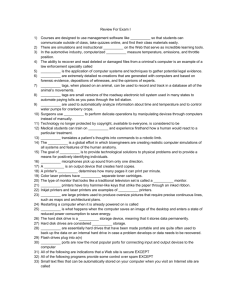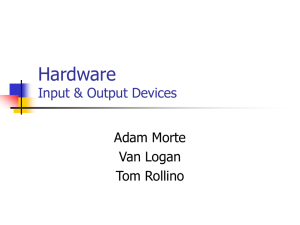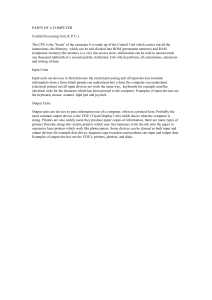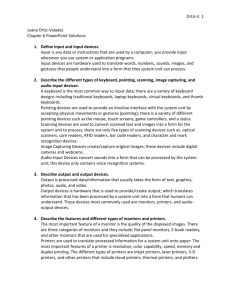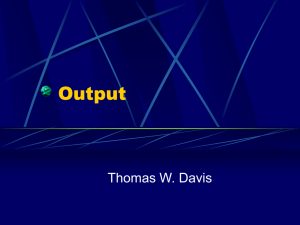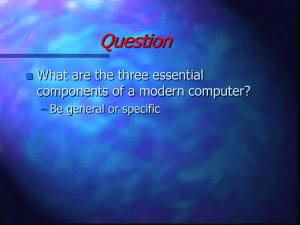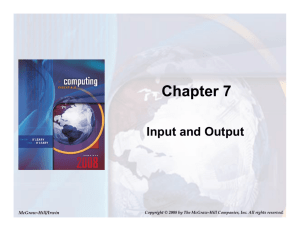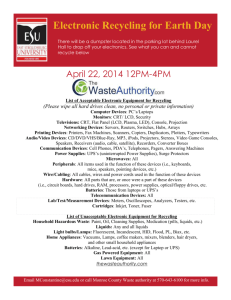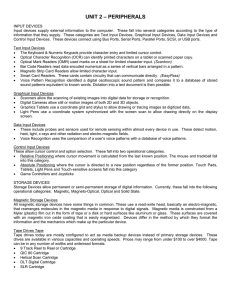Technology in Action
advertisement
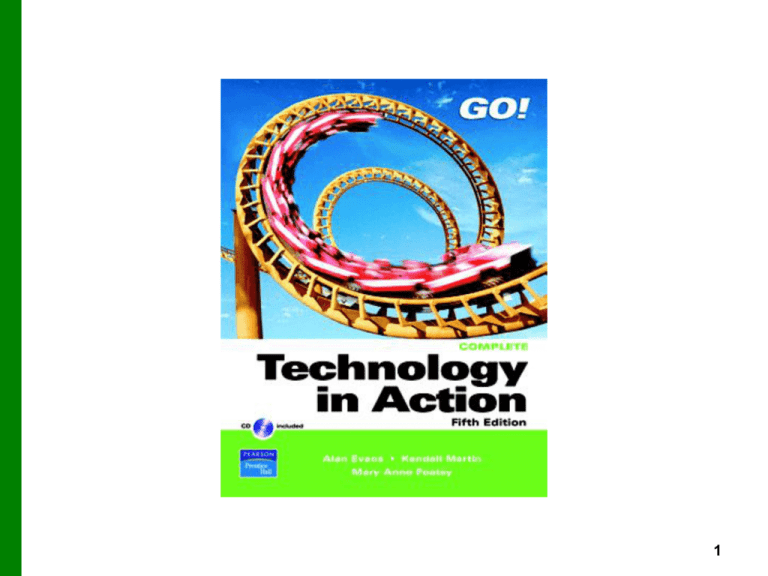
1 Technology in Action Chapter 2 Looking at Computers: Understanding the Parts 2 Chapter Topics • • • • • • • Functions of a computer Data versus information Bits and bytes Input devices Output devices System unit Ergonomics 3 Computers Are Data Processing Devices • Computer’s four major functions: – Gathers data (users input data) – Processes data into information – Outputs data or information – Stores data and information 4 Data vs. Information • Data: Representation of a fact or idea • Information: Organized, meaningful data 5 Bits and Bytes: The Language of Computers • Bit – Binary digit – 0 or 1 • Byte – Eight bits • Each letter, number, and character = a string of eight 0s and 1s 6 How Much Is a Byte? 7 Computer Software • Software: Programs that enable hardware to perform different tasks – Application software – System software 8 Computer Hardware 9 Input Devices • Devices used to enter information or instructions into the computer – Keyboard – Mouse/ pointing device – Microphone – Scanner – Digital camera – Stylus 10 Keyboards • The QWERTY layout is standard on most PCs • Enhanced keyboard features include number, function, and navigation keys. 11 Dvorak Keyboards • Puts the most commonly used keys on “home keys” • Reduces distance of finger stretches 12 Specialty Keyboards • • • • Notebook keyboard PDA stylus Tablet PCs Wireless keyboard 13 Mice • Optical mouse – Needs no mouse pad – Doesn’t need cleaning – Is more expensive • Trackball – Easier on wrists – Stays stationary on desk • Wireless – Use radio or light waves 14 New Mouse Features • Instant viewer • Magnifier • Customizable buttons • Web search 15 Other Input Devices • Scanners – Text – Images • Digital cameras Flatbed scanner Handheld scanner – Images – Video Digital camera Camcorder 16 Other Input Devices • EPOS Digital Pen • Web Cam – Live video 17 Inputting Sound • Microphones used for: – Podcasts – Videoconferencing – Internet phone calls – Speech recognition 18 Input Devices for the Physically Challenged • Visual impairments – Voice recognition – Keyboards with large keys – On-screen keyboards • Motor control issues – Special trackballs – Head-mounted devices 19 Output Devices • Send processed data out of the computer – Monitors – Printers • Output devices make: – Soft copies (video, sounds, control signals) – Hard copies (print) 20 Monitor Types • CRT Cathode Ray Tube • LCD Liquid Crystal Display – – – – – Less expensive Use much more space Use more energy Offer better viewing angles Legacy technology – – – – More expensive Use far less space More energy efficient Less viewable from an angle 21 Key Monitor Features • Screens are grids made up of millions of pixels. • LCDs: Liquid crystal is sandwiched between two transparent layers to form images • CRTs: Pixels illuminated by electron beam that passes back and forth across screen 22 LCD Quality Factors • Resolution • Passive vs. active matrix display • Viewing angle • Contrast ratio • Brightness • Response time 23 LCD versus CRT • LCD monitors: – take up less space – are generally brighter – cause less eyestrain – use less energy – weigh less • CRT monitors: – used to offer more resolutions – used to produce better color and clarity 24 Other Video Output • Touch-screen monitors – Double as both input and output devices • Data projectors – Project a computer image to a large screen for sharing with large groups 25 Printers • Impact printers – Dot-matrix • Nonimpact printers – Inkjet – Laser • Specialty printers – Multifunction – Plotters – Thermal printers 26 Nonimpact Printers • Inkjet – Less expensive device – Print high-quality color images cost effectively • Laser – More expensive device – Faster printing speed – Less expensive per page in B&W – Color lasers are becoming less expensive 27 Choosing a Printer • • • • • • Speed (ppm) Resolution (dpi) Color output Memory Use and cost Cost of consumables 28 Outputting Sound • Speakers and headphones 29 The System Unit • Box that contains the central electronic components of the computer: – CPU/RAM/ motherboard – Expansion cards – Power supply – Storage devices 30 The Front Panel • Power control • Drive bays • Memory card reader • Productivity ports 31 Power Controls • Power-on button: Turns on system, should not be used to turn it off • Other options: – Sleep mode – Hibernation – Warm boot 32 Drive Bays • Internal drive bays: – Cannot be access from outside the system – Reserved for internal hard drives • External drive bays: – Can be accessed from outside the system – CD or DVD drives – Floppy and Zip drives 33 Hard Disk Drive • Permanent (nonvolatile) storage • Internal or external versions 34 Flash Drives/Flash Memory • Flash drives (jump drives) – Newer storage alternative – Plug into USB ports • Flash memory cards – Slide into slots in the system 35 Storage Media Capabilities 36 On the Back • Ports for peripherals • Types of ports: – Serial and parallel – Audio and video – USB – FireWire – Connectivity • Ethernet • Modem 37 Inside the System Unit • Essential electronic components used to process data • Types of components: – – – – – Power supply Hard disk drive Motherboard CPU Expansion cards 38 The Motherboard • CPU • RAM • Expansion cards and slots • Built-in components 39 Central Processing Unit (CPU) • • • • Referred to as the “brains” of the computer Controls all functions of the computer Processes all commands and instructions Can perform billions of tasks per second 40 Memory Module • • • • Random access memory (RAM) Stores instructions and data Temporary (volatile) storage Operates in nanoseconds 41 Expansion Cards • Add functions • Provide new connections for peripheral devices • Common types: – Sound – Modem – Video (VGA) – Network (NIC) 42 Setting It All Up: Ergonomics • Ergonomics: minimizing injury or discomfort while using the computer • Steps to follow: – Position monitor correctly – Use adjustable chair – Assume proper position while typing – Take breaks – Ensure adequate lighting 43 Chapter 2 Summary Questions • What exactly is a computer, and what are its four main functions? 44 Chapter 2 Summary Questions • What is the difference between data and information? 45 Chapter 2 Summary Questions • What are bits and bytes, and how are they measured? 46 Chapter 2 Summary Questions • What devices do you use to get data into the computer? 47 Chapter 2 Summary Questions • What devices do you use to get information out of the computer? 48 Chapter 2 Summary Questions • What’s on the front of your system unit? 49 Chapter 2 Summary Questions • What’s on the back of your system unit? 50 Chapter 2 Summary Questions • What’s inside your system unit? 51 Chapter 2 Summary Questions • How do you set up your computer to avoid strain and injury? 52
